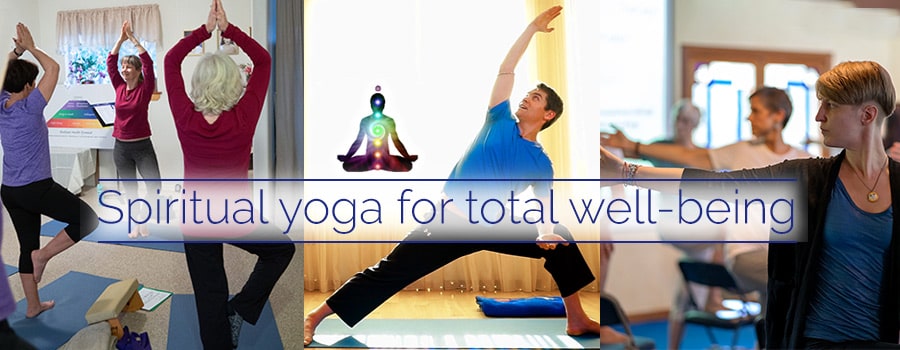Can Being Too Flexible Be Harmful?
In When Does Flexible Start to Mean Harmful?, Lorraine Kreahling asks, Does too much stretching cause injuries?
Ten to twenty years ago, when I was teaching yoga in San Francisco, one rarely heard of people being injured from practicing yoga.
During this time I worked both as a chiropractic assistant and in sports medicine research. To the extent that we saw yoga injuries at all, it was usually something that would be caused by going into or out of an inversion inappropriately. But even that was rare.
Recently, however, I’ve heard that the sports medicine clinic where I worked now treats yoga injuries more regularly than it did ten years ago. What has changed since then?
Getting to the Root of the Problem
First of all, the number of people practicing yoga has increased, which explains some of the increase in the number of injuries. It does not explain the situation entirely, however, because not only do there seem to be more injuries than increased numbers of participation can explain, but also there is a wider variety of types of injuries, especially for the knees and lower back, as reported in the above article. So what else has changed in the last ten years?
For one thing, there has been a great increase in the popularity of heat-based and power types of yoga, which tend to be fast-paced and to foster a certain degree of competitiveness. There are also a lot more yoga teachers with little or no formal training stepping up to meet the demand for these classes. More and more yoga students in power and hot yoga classes are getting injured more readily as they push the limits of their bodies with little, if any, regard to safety.
Lorraine Kreahling stated that some physical therapists question the value of excessive joint flexibility, saying that it can lead to inflammation and pain. Some asanas that require extreme bending of the knees such as squats and sitting backwards on folded knees (Vajrasana) were particularly cited by a sports medicine doctor as examples of postures that are most likely to cause tears in knee cartilage. This naturally raises the question of the safety of Vajrasana and similar asanas.
Flexible Muscles vs. Flexible Joints
To properly assess this safety issue, a distinction needs to be made: flexibility in joints is a different matter than flexibility in muscles.
Joints are where one bone connects with another bone. Joints (i.e., the connecting bones) are held together by ligaments. They are further stabilized by muscles and tendons. As Dr. James Garrick, M.D.[1], orthopedic surgeon and Director of the Sports Medicine Center at Saint Francis Hospital in San Francisco, states in his book, Peak Condition:
Ligaments have some elasticity. They can stretch a bit, but if they stretch over about 10 percent of their length, then they are like Saran Wrap — you stretch it too far and it stays that way. It won’t go back.
The job of ligaments is to help hold a joint in alignment, yet still allow for normal range of motion. If a ligament is over-stretched, then it is unable to stabilize the joint as well as it did before. The joint becomes more vulnerable to injury unless adequate muscle strength is developed to compensate for the extra looseness.
If the ligaments are stretched sufficiently — either from a sudden impact (such as a fall or impact), or over time (by overstretching them bit by bit) — the joint will be injured. There will then be inflammation and pain in the joint, for inflammation is the body’s mechanism for stabilizing the compromised joint.
The body can repair ligaments to a certain degree, but due to the low blood supply to the ligaments, as well as to the nature of the tissue they’re composed of, repair is slow and they are usually unable to return to their original state. To bring stability back to the joint, the supporting muscles then need to be built up more than usual in order to compensate for the stretched ligament(s).
Therefore, in yoga or any other activity, care should be taken never to stretch the ligaments. Dr. Garrick states in another of his books, Be Your Own Personal Trainer:
You should never feel the stretch in your joints. It’s virtually impossible to stretch joints. Stretching joints means stretching ligaments, and ligaments aren’t particularly elastic. They have a tendency to tear rather than stretch.
One indication that a joint is being stressed (therefore potentially overstretching the ligaments) is if there is any sensation inside the joint itself.
Understanding Range of Motion
So then we must ask, if a joint has a less-than-optimal range of motion, should we do anything to increase the range of motion? This is often referred to as stretching or opening up a joint. If the range of motion is restricted due to weak and/or tight muscles and tendons, then the answer is “yes”: we do want to increase the range of motion. If the range is limited due to the body’s structure (the bones and the ligaments), then, the answer is “no.”
Most of us never become so flexible as to feel that our bony structure is limiting us in our ability to go deeper into a posture. Back in my dancing days, I heard that in the not-so-distant past, the U.S.S.R. used to x-ray young, hopeful, ballerina girls’ hip joints to see if they had the maximum structural capability for 180 degree turnout. It sounds as though it was a terrible system, but I have to wonder if their ballerinas had fewer injuries caused by forced turnouts — and less need for hip replacements later in life — than their non-x-ray-selected counterparts in other countries.
Muscle is elastic and is meant to be flexible as well as strong. If flexibility is not maintained, the muscles will once again shorten. They have the ability to go back and forth from being short (inflexible) and being long (flexible) Tendons are the endpoints of the muscles where they attach to bones.
“Like ligaments, tendons are strong but not particularly elastic,” states Dr. Garrick. Tendons will stretch, but only so far before they too will become injured. Healthy muscles will have a balance between flexibility and strength. Overly flexible muscles without strength will not be able to support joints as well when they come under stress, thus predisposing one to joint injuries. Overly tight muscles reduce range of motion, which can limit daily activities and predispose one to straining or tearing muscles.
Can we be too flexible? Dr. Garrick cautions against being overly flexible. Striving for more and more flexibility without a good reason for it may indeed be courting trouble. Dr. Garrick asserts that it may be that stretching for its own sake may cause more problems than it prevents. So as yogis we must ask ourselves, Why do we want to become more flexible? It may be because we are rehabilitating an injury, and that specific stretches will help bring us back into balance.
Or perhaps we are compromised in our daily activities from a lack of flexibility. As yogis our main reason for increasing flexibility should be, to be healthy and to be comfortable sitting in meditation. A healthy body is easier to forget during meditation than an unhealthy, uncomfortable, nagging one.
So how flexible do we need to be? That depends on the individual. If a person is healthy and able to sit comfortably in a chair and go deep into meditation, then being able to put his foot behind his head is probably an unnecessary goal. Another individual may be motivated to experience the subtle energetic benefits of meditating in the lotus posture. If so, then a safe and gradually progressive asana practice of some of the deeper stretches may be appropriate. On the other hand, some bodies may not be meant ever to go into a full lotus position. Such differences must be respected.
Keys to Asana Safety
The injuries cited in Lorraine Kreahling’s New York Times article were most likely due to pushing one’s flexibility far beyond the natural range of the muscles. The ligaments and tendons then took the stress and became injured. It takes time to safely increase the flexibility of muscles; forcing a stretch is always a recipe for problems. As for the safety of Vajrasana, it must be taken in a case-by-case basis (as ultimately all yoga asanas should be viewed). If a person can sit in Vajrasana comfortably, and feel no sensations of pressure, tightness, or discomfort in their knees, then it can be a good asana for that individual. (In fact, some people with back problems find Vajrasana more comfortable, easier on the back, than other seated positions.)
If one feels the thighs stretching all the way to the knees, but not in the knee joints themselves, then it is okay. If there is some stress in the joints, often props can be used to alleviate the stress by decreasing knee flexion (e.g., sit on a cushion placed between the legs under the buttocks, or place a cushion between ankles and buttocks).
If, even after the use of props, one is still experiencing these sensations in the joints themselves, then that person should not practice Vajrasana until (if ever) he or she can do so safely.
If there is uncertainty as to whether the sensations are in the knee joint itself or an attaching tendon, or in the muscle, err on the side of caution and avoid the position. This approach should be taken with all asanas, since there never is a time that one should intentionally stretch ligaments. [2]
[image placeholder] Gastrocnemius (calf muscle) — medial & lateral heads Achilles tendon Ligaments Selected muscles, tendons, and ligaments in the right leg (posterior view) Hamstring tendons
Apparently what happens in “hot” yoga classes is that the climate — both temperature and social — and the teaching styles encourage pushing too far, too quickly into many positions. This results in muscle strains, tendonitis, ligament damage, and other joint injuries. It’s an issue of awareness rather than asanas — of how to teach and practice yoga appropriately.
Tips for the Teacher
Yoga asanas requiring a relatively high degree of flexibility have been around for thousands of years. History tells us of yoga’s therapeutic benefits, not of its injury rates. A competitive, purely physical, and superficial expression of the asanas is currently in vogue, and if it continues to produce a high rate of injuries, it is not likely to survive in that form. Ananda Yoga® teachers are lucky to be well trained, teaching the Ananda style of yoga.
If you ever experience more than a very occasional injury in your yoga classes, step back and review the basics. Are you giving thorough warm-ups to your students? Are you checking students’ alignment and teaching the asanas in stages (“building blocks”) to prepare students adequately for the full positions? Are you setting a noncompetitive tone in your classes? Are you practicing what you preach?
Furthermore, learning more about alignment and therapeutic yoga will help you help your students avoid injury. When I teach therapeutic yoga, I begin with, continue with, and end with teaching: (a) do no harm, and (b) alignment and body mechanics, for prevention as well as therapy.
Along with the physical nuts and bolts, attitude is very important. Be sure you are not competing with your own students. Keep bringing the focus inward and upward. A student who does that is not so aware of what the other students are doing, and therefore is unlikely to contribute to a competitive atmosphere.
Yoga should bring our bodies and minds into balance. Yoga should help heal our knees and backs as well as calming our minds. The consciousness and intention of our yoga practice and teaching are all important to the results of yoga practice. Clearly Ananda Yoga for Higher Awareness is good not only for our souls, but our minds and bodies as well.
Related Articles:
- Yoga for Multiple Sclerosis: A Research Study
- Italian Study: Ananda Yoga Proven to Help Multiple Sclerosis Patients
- What Is Therapeutic Yoga?
- Assessing and Correcting Posture
- Healthy Hips in Hatha Yoga
- Yoga after a Hip Replacement
- Therapeutic Yoga for the Lower Back
- Yoga Asanas and Stretches for The Lower Back
- Thoughts on Lengthening Ligaments
Footnotes
[1] As the research assistant for the Center for Sports Medicine, I coauthored an article for the Sports Medicine Journal with Dr. Garrick and Ralph Requa, the head of research, which reported on a large study of injury rates in all types of exercise and sports (yoga included — but this was long before it became so popular). That’s why I know that injury rates have increased. Dr. Garrick treated my knee injuries from dancing; his lesser claims to fame include being medical advisor to the National Football League, the U.S. Olympic Figure Skating Team, and the San Francisco Ballet.
[2] Exceptions would be in the case of rehabilitating ligaments that have scar tissue or other medical problems. However, it is so extremely easy to re-injure a ligament that even professionally trained health care providers must do so with caution; certainly it is beyond the scope of a yoga teacher (unless he or she has the appropriate specialized training and experience) to determine when and how this should be done. For more information, see More Thoughts on Lengthening Ligaments.
All authors are graduates of Ananda Yoga Teacher Training.





















